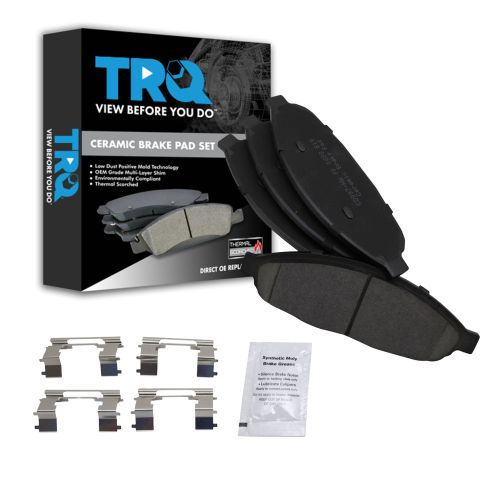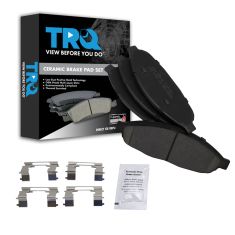Replaces
2004-08 Chrysler Pacifica Front Ceramic Brake Pads TRQ BFA73151


BFA73151
This part doesn’t fit a . Select from parts that fit.
Specify your vehicle's year, make and model to guarantee fit.
This part doesn't fit a . Select from parts that fit.
Buy in the next and
Orders must be placed by 2pm ET
Frequently bought together
Specify your vehicle's year, make and model to guarantee fit.
This part doesn't fit a . Select from parts that fit.
Part Details
- 0.63 in
- 16 mm
- 0.63 in
- 16 mm
- No
- Bonded
- Yes
- No
- Yes
- 2.36 in
- 60 mm
- Contact Point Grease
- Hardware
- 7.28 in
- 185 mm
- Yes
- 4
- N
- Premium Posi
- Ceramic
- Ceramic
- Black
- Black
- 0.63 in
- 16 mm
- Yes
- No
- Yes
- No
- 185 mm
- 7.28 in
- Yes
- No
- 0.63 in
- 16 mm
- Steel
- 2.36 in
- 60 mm
- R-S-R
- No
- Yes
- Standard Replacement
About TRQ:
TRQ is a trusted brand dedicated to making every repair a success story by combining premium parts with easy installation. Each TRQ part is engineered by a team of automotive experts to meet or exceed OEM standards, delivering enhanced performance and maximum longevity. With rigorous in-house testing, the brand ensures superior fit and function across every product line. TRQ also provides customers with best-in-class, step-by-step installation videos—so you can complete repairs with confidence, whether you're a first-time DIYer or an industry professional.
Product Features
TRQ brake pads are manufactured using premium raw materials and design standards to restore original performance. TRQ brake pads are positive molded and utilize a multi-layer shim for enhanced performance and service life. TRQ’s combination of materials and design ensures a low dust and low noise braking experience. TRQ recommends replacing your brake rotors when you replace your brake pads to ensure even wear of components and improved braking comfort. All products are fit and road-tested in our Massachusetts R&D facility to ensure we deliver on our promise of Trusted Reliable Quality.
Attention California Customers:
![]() WARNING: This product can expose you to chemicals including Lead and Lead Compounds, which are known to the State of California to cause cancer, and birth defects or other reproductive harm. For more information, go to www.P65Warnings.ca.gov.
WARNING: This product can expose you to chemicals including Lead and Lead Compounds, which are known to the State of California to cause cancer, and birth defects or other reproductive harm. For more information, go to www.P65Warnings.ca.gov.
Lifetime Warranty
This item is backed by our limited lifetime warranty. In the event that this item should fail due to manufacturing defects during intended use, we will replace the part free of charge. This warranty covers the cost of the part only.
FREE Shipping is standard on orders shipped to the lower 48 States (Contiguous United States). Standard shipping charges apply to Hawaii and Alaska.
Shipping is not available to a P.O. Box, APO/FPO/DPO addresses, US Territories, or Canada for this item.
Expedited is available on checkout to the United States, excluding Alaska, Hawaii.
Final shipping costs are available at checkout.


Created on:
Tools used
- Pry off the center cap with a flat blade screwdriver Loosen the lug nuts with the vehicle on the ground Raise the vehicle with a floor jack Secure the vehicle on jack stands Remove the lug nuts Pull off the wheel
- Check for gouges on both sides of the rotor Check the thickness of the brake pads Check the brake pad wear indicator
- Turn the rotor by hand or turn the steering wheel to turn the rotor Pry the pads into the caliper with a flat blade screwdriver or a pry bar Remove the two 14mm bolts from the brake caliper Pry the caliper off with a flat blade screwdriver Pull the caliper aside Pry the brake pads off with a flat blade screwdriver
- Remove the two 21mm bolts from the brake caliper bracket Pull off the brake caliper bracket Pull the rotor off
- Clean the brake pad slides with a wire brush Slide the rotor on Thread on one lug nut to hold the rotor in place Put the bracket back into place Start the two 21mm bolts by hand Tighten the bolts to 110 foot-pounds of torque Check that the caliper slides move freely If they do not move freely, apply grease
- Put an old pad in the caliper Use a large C-clamp and the old pad to push the pistons back Install the new brake pads into the bracket Put the caliper on Thread the two 14mm bolts by hand Tighten the 14mm bolts to between 22 - 25 foot-pounds
- Remove the placeholder lug nut Slide the wheel into place Start the lug nuts by hand Tighten the lug nuts preliminarily Lower the vehicle to the ground Tighten the lug nuts to 100 foot-pounds in a crossing or star pattern Reattach the center cap
- Pump your brakes repeatedly until they feel firm Test your brakes at 5 miles per hour and then 10 miles per hour Road test the vehicle
Brought to you by 1AAuto.com, your source for quality replacement parts and the best service on the Internet.
Hi, I'm Mike from 1A Auto. I hope this how-to video helps you out, and next time you need parts for your vehicle, think of 1AAuto.com. Thanks.
In this video, we're going to show you how to do a front brake job on this Chrysler Pacifica. We show you the front right hand, or front passenger side. Obviously, the driver's side is the same process, and we always do recommend that you change them in pairs. The tools you'll need for this job are jack and jack stands, 14 to 21 mm sockets, ratchets and extension, large flat blade screwdriver or small pry bar, large C-clamp, small wire brush, and a torque wrench.
Start by removing the cover. Next remove the lug nuts. You'll probably want to start with the wheel on the ground, loosen the lug nuts first, then raise and support the vehicle, and then remove them. Fast forward, here, as I just remove the rest of the lug nuts and then remove the wheel and tire.
Now, you can inspect the brakes and even though these brakes look a little rusty, that's not a big deal. It looks like this car has just been sitting for a while. You want to take the back of your fingernail, run it up and down the rotor. You'll feel some small groves, but you shouldn't feel anything deep. Then, also, you can look right in here and spin the rotor. You can see, here's the brake pad in between the metal here. It's nice and thick on the inside, as well as, you can see it's nice and thick here. This actually has good brakes on it but I'll take them apart and put it back together just to show you.
Turn your brakes. Here, on the back side, you'll want to remove these two bolts first. Before you remove those bolts you can take a large screwdriver or a small pry bar and put it here and just press this way, pry this way. That just helps push the pistons back into the caliper some and it makes it easier to get the caliper off. These bolts are 14mm, so they should not be too hard to remove. Speed up here as I remove those the rest of the way. Once you have those off, you can get the pads to just pry right up easily. Like I said, you can see these lines in the middle are wear marks. You can see these have quite a bit of life left.
If you want to replace the caliper you want to remove these two large bolts here. These two bolts are 21mm. I'm going to put my ratchet on there and use a piece of pipe for some extra leverage, slow and easy. These are actually coming apart pretty easily, maybe a little too easily. Fast forward here as I remove those bolts. Those bolts, as you'll see later, are tightened to 110 foot pounds. I have a feeling that whoever put this together before didn't tighten them up as much as they should have.
Before you put this back together, sometimes new pads will come with these slides that you'd actually just pull them right off with just a little bit of force. If your new pads don't come with the slides then you'll want to take a wire brush and just clean them up a little bit. Put the rotor back on. Put this back in place. Start the bolt from the back side. Just move this around until you get the bolt going in. I like to take just one lug nut and put it on. It just helps keep stuff in place. I'll speed up here, as I just tighten those bolts preliminarily. Torque these two bolts to 110 foot-pounds. Now, you want to make sure these two slides go back and forth nice and easy. If they don't move freely, then you can pull them out, clean them up, and grease them and put them back together to get them to move free.
Now you want to reset your caliper. What happens is, as the brakes wear, these two pistons actually work themselves out of the caliper. What you'll want to do is take your old inside pad and put it in place. Get a large C-clamp and put it on, and as you tighten the C-clamp it pushes those pistons back into the caliper. They just go right into place. To put the pads in place, the caliper just goes right down on them. You push these slides in a little bit and calipers slide on. Then put the two bolts in. These bolts should be tightened between 22 and 25 foot-pounds.
Fast forward here as I straighten it up, take off that lug nut, then put my wheel and tire back in place. Thread all the lug nuts back on hand, make sure don't cross thread them, and then tighten the lug nuts preliminarily. Now, torque your lug nuts using a star pattern to 100 foot-pounds. And last, but certainly not least, make sure after you do your brake work, obviously, we showed you the left hand side, then do the left hand side, then pump your brakes up. Get a nice hard pedal before you road test the vehicle.
We hope this video helps you out. Brought to you by www.1AAuto.com, your source for quality replacement parts and the best service on the Internet. Please feel free to call us toll-free, 888-844-3393. We're the company that's here for you on the Internet and in person.

BFA73151
877-844-3393
Monday - Friday 8:00am - 9:30pm ET
Saturday - Sunday 8:00am - 4:30pm ET
Specify your vehicle's year, make and model to guarantee fit.
This part doesn't fit a . Select from parts that fit.









